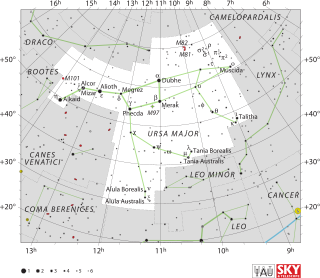| Observation data Epoch J2000.0 Equinox J2000.0 | |
|---|---|
| Constellation | Ursa Major |
| Right ascension | 08h 30m 15.87064s[1] |
| Declination | +60° 43′ 05.4115″[1] |
| Apparent magnitude (V) | +3.35[2] |
| Characteristics | |
| Spectral type | G5III:[3] |
| U−B color index | +0.52[4] |
| B−V color index | +0.85[4] |
| Astrometry | |
| Radial velocity (Rv) | +19.8[5] km/s |
| Proper motion (μ) | RA: -133.644[6] mas/yr Dec.: -107.664[6] mas/yr |
| Parallax (π) | 17.9335 ± 0.1456 mas[6] |
| Distance | 182 ± 1 ly (55.8 ± 0.5 pc) |
| Absolute magnitude (MV) | –0.40[7] |
| Details[8] | |
| Mass | 2.72 M☉ |
| Radius | 13.84 R☉ |
| Luminosity | 116 L☉ |
| Surface gravity (log g) | 2.58 cgs |
| Temperature | 5,242[7] K |
| Metallicity [Fe/H] | −0.16+0.08 −0.1 dex |
| Rotational velocity (v sin i) | 3.83[9] km/s |
| Age | 360 ± 30[10] Myr |
| Other designations | |
| Database references | |
| SIMBAD | data |
Omicron Ursae Majoris (ο Ursae Majoris, abbreviated Omicron UMa, ο UMa), formally named Muscida /ˈmjuːsɪdə/,[12][13] is a star system in the northern circumpolar constellation of Ursa Major. It has an apparent visual magnitude of +3.35[2] and is located at a distance of around 179 light-years (55 parsecs) from the Sun.[1] In 2012, an exoplanet designated Omicron Ursae Majoris Ab was found to be orbiting the primary.[9]
- ^ a b c Cite error: The named reference
aaa474_2_653was invoked but never defined (see the help page). - ^ a b Cite error: The named reference
aaa352_495was invoked but never defined (see the help page). - ^ Cite error: The named reference
perkinswas invoked but never defined (see the help page). - ^ a b Cite error: The named reference
clpl4was invoked but never defined (see the help page). - ^ Cite error: The named reference
gcsrvwas invoked but never defined (see the help page). - ^ a b c Brown, A. G. A.; et al. (Gaia collaboration) (2021). "Gaia Early Data Release 3: Summary of the contents and survey properties". Astronomy & Astrophysics. 649: A1. arXiv:2012.01533. Bibcode:2021A&A...649A...1G. doi:10.1051/0004-6361/202039657. S2CID 227254300. (Erratum: doi:10.1051/0004-6361/202039657e). Gaia EDR3 record for this source at VizieR.
- ^ a b Cite error: The named reference
pasj60_4_781was invoked but never defined (see the help page). - ^ Cite error: The named reference
Teng2023was invoked but never defined (see the help page). - ^ a b Cite error: The named reference
Sato2012was invoked but never defined (see the help page). - ^ Cite error: The named reference
aaa480_1_91was invoked but never defined (see the help page). - ^ Cite error: The named reference
SIMBADwas invoked but never defined (see the help page). - ^ Kunitzsch, Paul; Smart, Tim (2006). A Dictionary of Modern star Names: A Short Guide to 254 Star Names and Their Derivations (2nd rev. ed.). Cambridge, Massachusetts: Sky Pub. ISBN 978-1-931559-44-7.
- ^ "IAU Catalog of Star Names". Retrieved 28 July 2016.
